
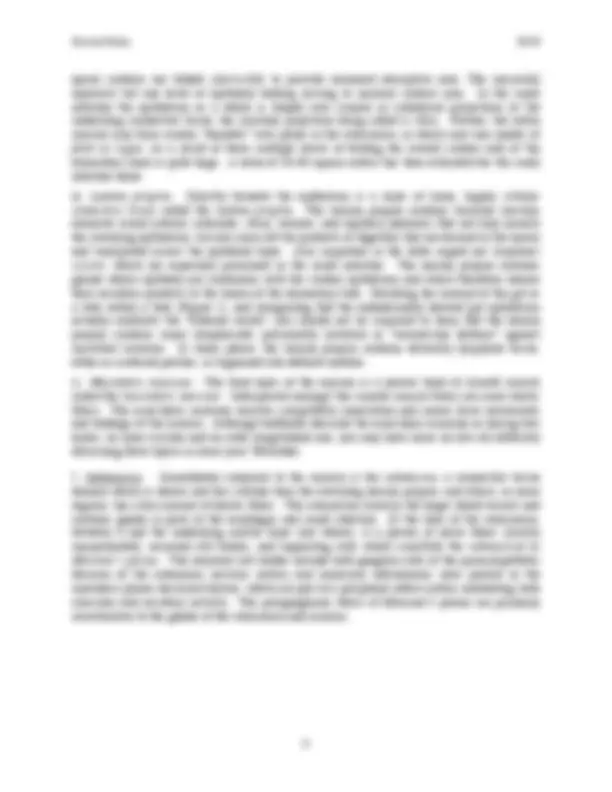
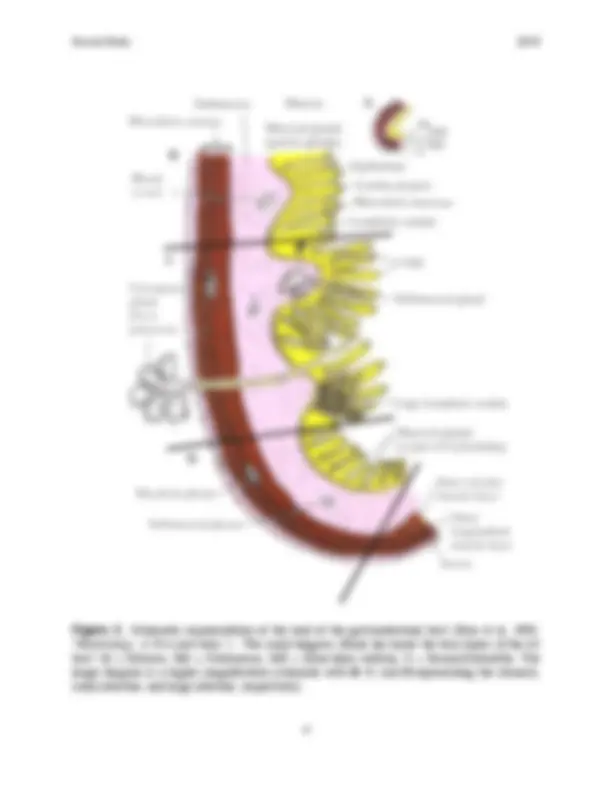
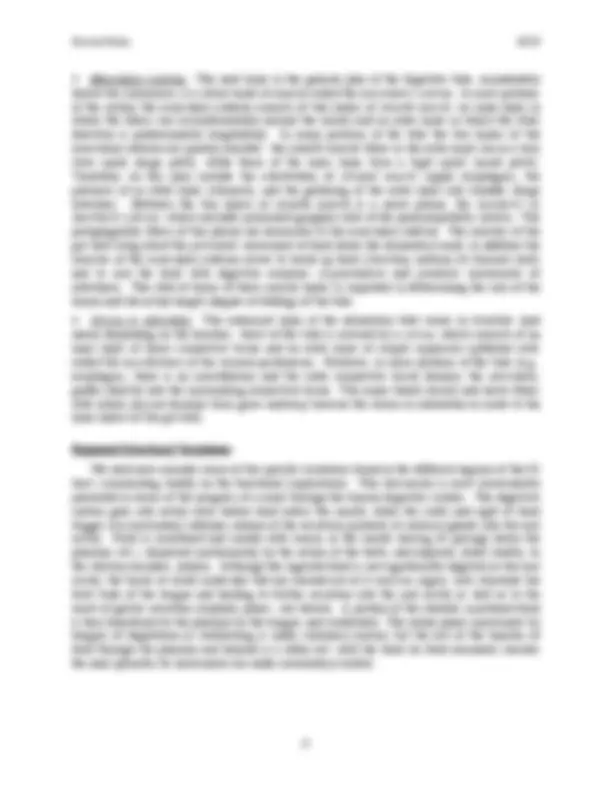
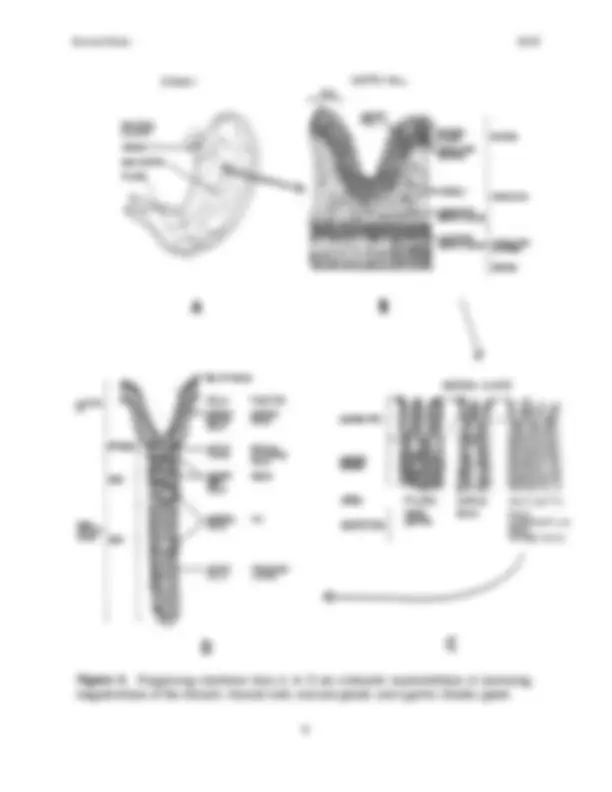
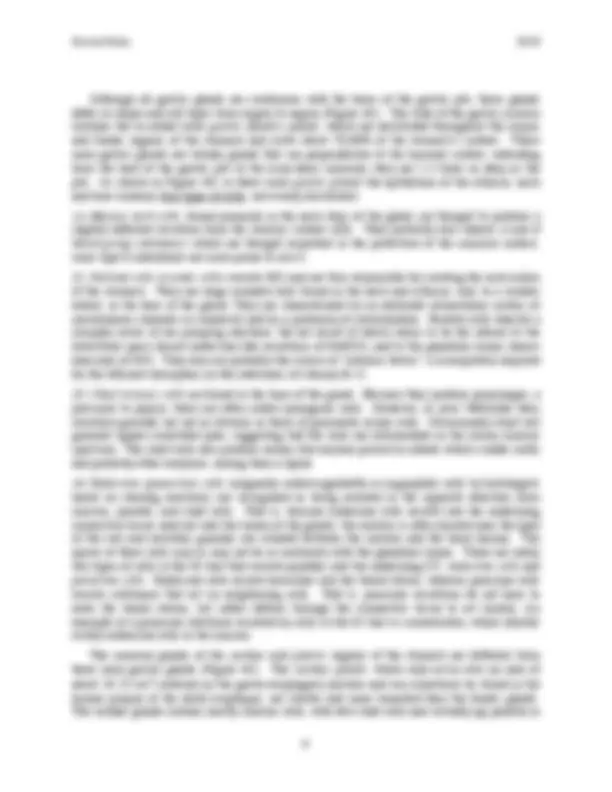

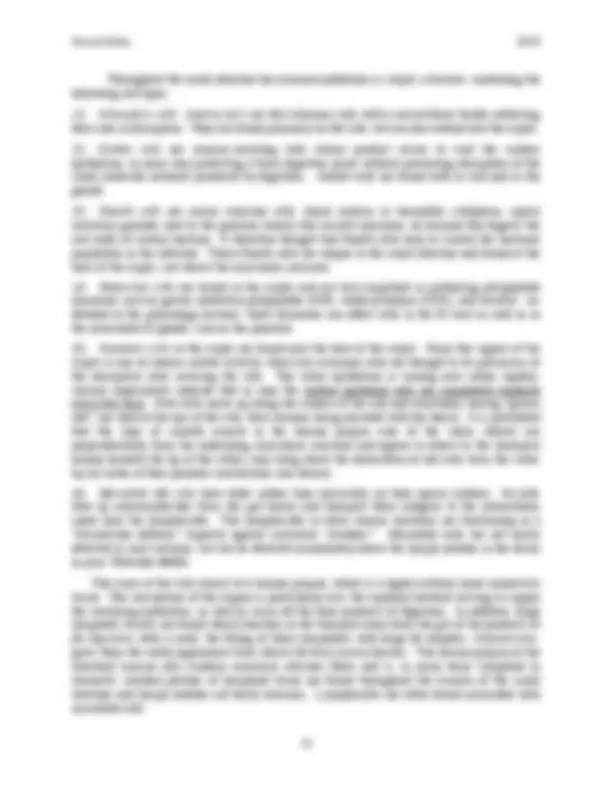
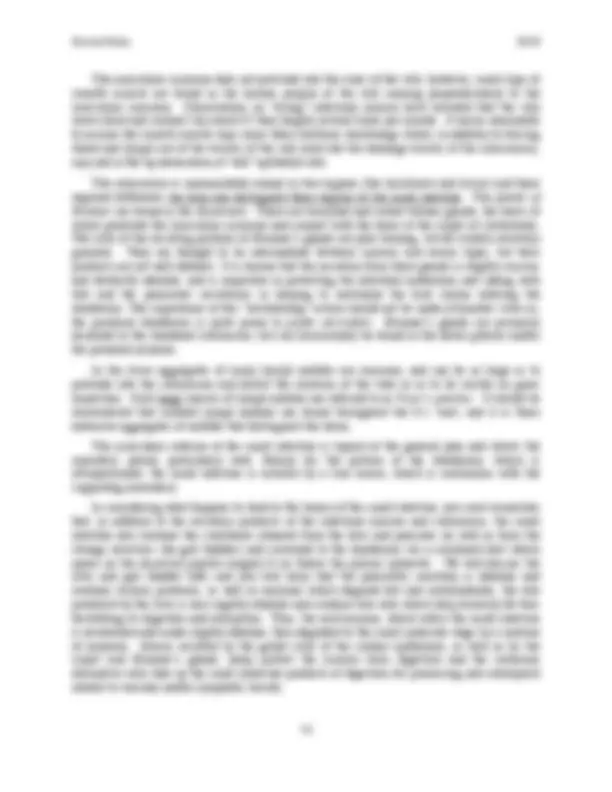
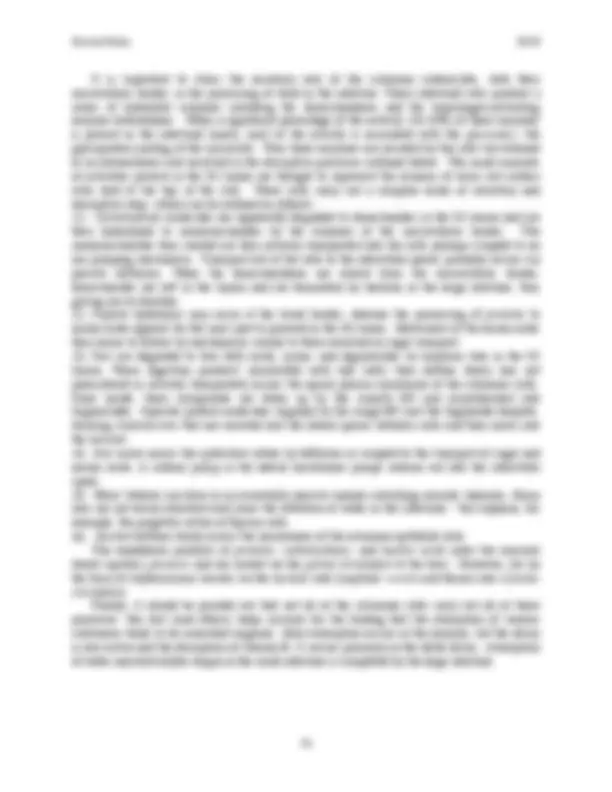



Study with the several resources on Docsity

Earn points by helping other students or get them with a premium plan


Prepare for your exams
Study with the several resources on Docsity

Earn points to download
Earn points by helping other students or get them with a premium plan
Community
Ask the community for help and clear up your study doubts
Discover the best universities in your country according to Docsity users
Free resources
Download our free guides on studying techniques, anxiety management strategies, and thesis advice from Docsity tutors
An in-depth exploration of the structural features and functions of the esophagus, stomach, small intestine, and large intestine. It discusses the different types of epithelial cells and their roles in absorption, secretion, and protection. The text also covers the nervous system's role in muscle contractions and the various glands' functions.
What you will learn
Typology: Study Guides, Projects, Research
1 / 18

This page cannot be seen from the preview
Don't miss anything!











Introduction In the next lectures and laboratory exercises we will discuss and examine the microscopic anatomy of the various parts of the digestive, or alimentary, system. Since this is a large and complex organ system, our coverage will not be total. We shall focus first on general principles and then proceed to a limited discussion of specifics, leaving it to you, by your readings, to round out the picture as time and inclination permit. You have examined the gastrointestinal tract in your cadavers and have learned the development of the system in the EMBRYOLOGY lecture. Functional correlates of the various structural features will be covered in detail in Physiology lectures. It is fairly common to discuss the digestive system in three segments: a) The oral cavity (including teeth and tongue) and the pharynx. b) The digestive tube (or alimentary canal, or gastrointestinal tract) including esophagus, stomach, small intestine, and large intestine. c) The accessory organs including salivary glands, pancreas, liver and gall bladder. We shall not cover the elements of (a) in either lectures or labs. In the next two lectures and labs we shall consider the g.i. tract proper and then in subsequent lectures and lab we will study the accessory organs. General Plan for the GI Tract: Lecture 1: Organizational principles, esophagus and stomach Lab 1: Webslide examination of esophagus and stomach Lecture 2: Small and large intestine Lab 2: Webslide examination of small and large intestine The Alimentary Tube****. The digestive system (Figure 1) is a set of organs that function in the ingestion and digestion of food, the absorption of the useful products of that digestion, and the egestion of the waste products. The mouth and associated structures serve to select the food, separate it from the air, and, to a limited extent, process it mechanically and chemically. For the most part the business of the digestive system is carried out by the alimentary or gastrointestinal tube proper, a long (approximately 10 meters in humans), tortuous, fibromuscular pipeline which is structurally organized to transport food from mouth to anus, and in the process to disperse it mechanically, break it down chemically, and absorb the nutritive small molecules thus produced. As a rough approximation, the daily input to the system is about 500 grams of solid matter and 2.5 liters of water; after a processing time of 24-48 hours, the exiting residuum (faeces) consists of approximately 30 gm of solids and 100 ml of water. In these two lectures we shall discuss the structural features of the esophagus, stomach, small intestine, and large intestine as a basis for understanding their various functions.
Figure 1. Organs of the digestive system General Plan In the wall of all parts of the alimentary tube four layers can be recognized: progressing outward from the lumen these are (1) the mucosa , (2) the submucosa , (3) the muscularis externa , and (4) the serosa or adventitia (Figure 2).
Figure 2. Schematic representation of the wall of the gastrointestinal tract (Ross et al, 1995. “ Histolology: A Text and Atlas” ). The small diagram (Panel A) shows the four layers of the GI tract: M = Mucosa, SM = Submucosa, ME = Muscularis externa, S = Serosa/Adventitia. The larger diagram is a higher magnification schematic with B , C , and D representing the stomach, small intestine, and large intestine, respectively.
the so-called lower esophageal sphincter (LES), which prevents reflex of gastric juices into the esophagus. As an anatomical entity the LES is less distinct than the pyloric sphincter (see below). Some authors report a slight thickening of the inner (circular) muscular layer at this point, whereas others claim that a flap or fold of mucosa hangs down to block or partially block the lumen. Apparently, the muscle cells in this region are specifically innervated in some poorly understood fashion. Furthermore, the stomach hormone gastrin (see below) affects the muscle cells of the LES. Except where it closely approaches the pleura, the cervical and thoracic esophagus is surrounded by adventitia ; the small portion (about 2 cm) within the abdominal cavity and connecting with the stomach is covered by a serosa (peritoneum). Stomach The food bolus, having traversed the esophagus, reaches the stomach (Figure 4), a fibromuscular bag whose functions include storage as well as mechanical and chemical processing of the food. The stomach can be divided into four anatomical regions (Figure 4A): the cardiac region is adjacent to the esophagus, the fundic region is above the level of a horizontal line drawn through the esophageal orifice, the corpus (body) comprises the main central region, and the pylorus ( pyloric antrum ) is the region adjacent to the small intestine. At the gastroesophageal junction between the esophagus and the cardiac stomach there is a striking and abrupt transition of the surface epithelium from stratified squamous in the esophagus to simple columnar in the stomach. The stomach has a storage capacity of 1/2 to 1 liter, the exact reservoir size depending on the degree of stretching of the convoluted walls. These convolutions are called rugae , which are the macroscopic folds observed in dissection of the stomach. The rugae, which run predominantly longitudinally, are upthrusting folds of the submucosa upon which is draped the entire mucosa. These rugae are almost completely flattened out in the distended (full) stomach. Examination of the stomach mucosa with the Virtual Microscope at fairly low magnification reveals that the surface epithelium is not smooth, but is folded into mucosal glands (illustrated in Figures 2B, 4B, 4C, and 4D). The folding pattern of these glands is unique to the stomach and therefore key to identifying the stomach in Virtual Microscopy sections. Specifically, the stomach mucosal glands can be divided into two distinctive regions: gastric pits and gastric glands. The fairly wide gastric pits extend from the lumen into the lamina propria, about 1/4 to 1/3 of the way to the muscularis mucosae. At the base of the wide pits the epithelium turns into gastric glands, which are narrower in diameter than the pits and extend down to the muscularis mucosae (Figures 4B and C). Simple columnar epithelium lines the surface of the pits and glands throughout the stomach (Figure 4D). All of the surface cells in the pits produce a mucous secretion and are therefore referred to as mucous surface cells (Figure 4D). These rectangular mucous surface cells are different from the goblet cells seen in the intestinal epithelium, which are distended apically (hence the term goblet ) by their secretory product. The mucous surface cells differ in appearance from the mucous neck cells of the glands in the lamina propria, because there is often less secretory product visible in the cytoplasms of the neck cells (Figure 4D). However, the types of epithelial cells in the glands vary, depending on the region of stomach, as described in the next section.
Figure 4. Progressing clockwise from A to D are schematic representations at increasing magnifications of the stomach, stomach wall, mucosal glands, and a gastric (fundic) gland.
endocrine cells. Over the approximately 15% of the stomach mucosa centered on the pyloric sphincter are pyloric glands , whose gastric pits are deeper and whose glands are often more coiled and branching than the main gastric glands. Although in humans the pyloric glands contain a few parietal cells, there are essentially no chief cells, the main type being a cell with a rather pale, apparently mucous-containing cytoplasm. These pyloric glands do contain endocrine cells, which produce the polypeptide hormone gastrin. Gastrin is released into the circulation when food enters the stomach and stimulates release of the acid secretions of the main gastric gland--a stimulation that is counteracted when the acidity of the stomach contents gets too high. As previously noted, gastrin also affects the muscularis in the LES. Because the stomach mucosa is packed with glandular epithelium, the lamina propria is not obvious as a continuous layer, being found essentially as thin strands between the glands. The muscularis mucosae is prominent in the stomach as a distinct layer delimiting the bases of the mucosal glands. Elastic fibers of the submucosa account for the stretch ability of these folds and thus the dispensability of the stomach. The Meissner’s plexus of the stomach submucosa is fairly prominent, the fibers being secretomotor to the mucosal glands. The muscularis externa is quite robust in the stomach. In the cardiac region there is an additional, innermost , layer of obliquely oriented smooth muscle fibers, which is scanty elsewhere in the stomach and often difficult to see in a given histological preparation. In the stomach, the middle layer of circularly oriented smooth muscle is thickened at the juncture between the pyloric stomach and the small intestine (duodenum) forming the pyloric sphincter. A true serosa surrounds all regions of the stomach. Food, having traversed the esophagus rapidly, spends a few minutes to a few hours within the stomach. During this interval, the food is blended with the copious (up to 1.5 liters/day) acid secretions of the gastric mucosa, thorough mixing being assured by the churning and peristaltic actions of the muscularis externa. The most vigorous mixing occurs in the pyloric antrum and the longitudinally oriented rugae tend to funnel the food, repeatedly displaced upward by the churning of the muscularis, back down to the pylorus. Exposure to the acid mixture of gastric enzymes converts the fairly solid ingesta into a creamy semi-solid mass called chyme , which, in small portions, is passed through the pyloric sphincter to the duodenum. While food is thus at least partially digested in the stomach, little absorption takes place there, with the exceptions of water and alcohol. Thus, the stomach functions as a preprocessing plant for the small intestine. Although these preprocessing operations are highly useful, they are not indispensable, since persons with total gastrectomy seem to function quite well. The highly acid milieu of the stomach (pH approximately 1.0 to 1.5) is suitable for the actions of the gastric enzymes and also has a bacteriocidal or bacteriostatic effect. This acidity, which is entirely due to the actions of the parietal cells, poses severe problems for the gastric mucosa--problems that appear to have been solved by extensive overproduction of mucous material which coats and protects the epithelium. Nevertheless, the wear and tear on the epithelium of the gastric mucosa is significant and there is extensive cell turnover. The mucous surface cells seem to be replenished by virtue of mitotic activity in the isthmus regions of the fundic glands, but the turnover of parietal and chief cells is less well understood. Exactly how the stomach normally manages the trick of not totally digesting itself is not clear and the frequency of peptic ulcers of the gastric mucosa is a testimony to the fact that the mechanism isn’t perfect. With regard to the recognized connection between tension (or anxiety) and ulcers, you should realize that the control of gastric secretion (which can range from a basal rate of
about 10 ml/hr to more than 100 ml/hr) involves an initial cephalic phase (psychic factors including emotional state, sight and smell of food, etc.), a second gastric phase (ingested food directly or indirectly, via gastrin, induces secretion), and a third or intestinal phase (in which products of the intestinal mucosa enter the circulatory system and further stimulate gastric secretion). Small Intestine The partially digested food (chyme) passes through the pyloric sphincter and into the small intestine (Figure 5). This is a tube some 7 meters long in humans consisting of, in proximo- distal order, the duodenum (about 25 cm), the jejunum (2.5 to 3 meters) and the ileum (about 4 meters). In the small intestine the degradative phase of digestion is essentially completed and most absorption of nutrients occurs. Accordingly the mucosa is highly specialized, primarily for absorption, but also for secretion. To facilitate absorption, the intestinal wall has a very large surface area due to the folding of the mucosal elements at three levels; (1) The entire mucosa is thrown into deep folds called plicae circulares , which run circumferentially or spirally (upper right hand panel of Figure 5A). Plicae begin in the distal duodenum, reach maximal size in the jejunum, begin to diminish in the ileum, and are nearly absent in the distal ileum. The large plicae of the jejunum may project up to 1 cm into the intestinal lumen. Unlike the longitudinal folds or rugae of the stomach, the plicae of the intestine are not flattened out when the lumen is full. (2) Superimposed upon the plicae, the epithelium and lamina propria (but not the muscularis mucosae) contain smaller folds called villi and crypts (glands). Villi (unique to the small intestine in the GI tract) are projections into the lumen of up to 1 mm in length that cover the intestinal wall giving it the velvety texture observed in gross dissection (Figure 5A and B). It is said that the villi of the duodenum are broad and leaf-like, those of the jejunum are tall and tongue-like, and that those of the ileum are shorter and more finger-like. However, such distinctions may not be possible with your slide materials as there are often quite wide variations from this “general” plan and there is a continuous gradation from one to the other. Villi are not static entities; their surface epithelium is being continuously renewed and the villi are in constant, functionally significant, motion. In between the villi are places where epithelium extends down into the mucosa in glands or intestinal crypts ( crypts of Lieberkuhn). (3) Some intestinal epithelial cells contain closely packed microvilli ( striated border ) at their apical surfaces. Microvilli are about 0.5 to 2 μm in length, approximately 0.1 μm in diameter, and since the number per cell may be several thousand, the surface membranes of these absorptive cells (enterocytes) extend over very large areas.
Throughout the small intestine the mucosal epithelium is simple columnar , containing the following cell types. (1) A bsorptive cells (enterocytes) are tall columnar cells with a microvillous border reflecting their role in absorption. They are found primarily on the villi, but can also extend into the crypts. (2) G oblet cells are mucous-secreting cells whose product serves to coat the surface epithelium, in some way protecting it from digestive juices without preventing absorption of the small molecule nutrients produced by digestion. Goblet cells are found both in villi and in the glands. (3) Paneth cells are serous exocrine cells (basal nucleus in basophilic cytoplasm, apical secretory granules next to the granular lumen) that secrete lysozyme, an enzyme that digests the cell walls of certain bacteria. It therefore thought that Paneth cells help to control the bacterial population in the intestine. These Paneth cells are unique to the small intestine and found at the base of the crypts, just above the muscularis mucosae. (4) Endocrine cells are found in the crypts and are very important in producing polypeptide hormones such as gastric inhibitory polypeptide (GIP), cholecystokinin (CCK), and secretin. As detailed in the physiology lectures, these hormones can affect cells in the GI tract as well as in the associated GI glands, such as the pancreas. (5) Immature cells in the crypts are found near the base of the crypts. Since this region of the crypts is one of intense mitotic activity, these low columnar cells are thought to be precursors of the absorptive cells covering the villi. The villus epithelium is turning over rather rapidly; various experiments indicate that in man the surface epithelial cells are completely replaced every few days. New cells move up along the surface of the villi and eventually, having “grown old”, are shed at the tips of the villi, their remains being excreted with the faeces. It is postulated that the slips of smooth muscle in the lamina propria core of the villus (which run perpendicularly from the underlying muscularis mucosae and appear to attach to the basement lamina beneath the tip of the villus) may bring about the dislocation of old cells from the villus tip by virtue of their periodic contractions (see below). (6) Microfold (M) cells have folds (rather than microvilli) on their apical surfaces. M cells take up macromolecules from the gut lumen and transport these antigens to the intercellular space near the lymphocytes. The lymphocytes in these various locations are functioning in a “second-line defense” capacity against microbial “invaders”. Microfold cells are not easily detected in most sections, but can be detected immediately above the lymph nodules in the ileum in your Webslide #0096. The cores of the villi consist of a lamina propria, which is a highly cellular loose connective tissue. The vasculature of this region is particularly rich, the capillary network serving to supply the overlying epithelium, as well as carry off the final products of digestion. In addition, large lymphatic vessels are found which function in the transport away from the gut of the products of fat digestion ; after a meal, the filling of these lymphatics with large fat droplets, chylomicrons , gives them the milky appearance from which the term lacteal derives. The lamina propria of the intestinal mucosa also contains numerous reticular fibers and is, in many ways, lymphoid in character: isolated patches of lymphoid tissue are found throughout the mucosa of the small intestine and lymph nodules are fairly common. Lymphocytes are often found associated with microfold cells.
The muscularis mucosae does not protrude into the cores of the villi; however, small slips of smooth muscle are found in the lamina propria of the villi running perpendicularly to the muscularis mucosae. Observations on “living” intestinal mucosa have revealed that the villi wave about and contract (by about l/2 their length) several times per minute. It seems reasonable to assume the smooth muscle slips cause these rhythmic shortenings which, in addition to forcing blood and lymph out of the vessels of the villi (and into the drainage vessels of the submucosa), may aid in the tip dislocation of “old” epithelial cells. The submucosa is unremarkable except in two regions (the duodenum and ileum ) and these regional difference can help one distinguish these regions of the small intestine. The glands of Brunner are found in the duodenum. These are branched and coiled tubular glands, the ducts of which penetrate the muscularis mucosae and connect with the bases of the crypts of Lieberkuhn. The cells of the secreting portions of Brunner’s glands are pale staining, but do contain secretory granules. They are thought to be intermediate between mucous and serous types, but their products are not well defined. It is known that the secretion from these glands is slightly viscous and distinctly alkaline, and is important in protecting the intestinal epithelium and (along with bile and the pancreatic secretions) in helping to neutralize the acid chyme entering the duodenum. The importance of this “neutralizing” action should not be under-estimated: even so, the proximal duodenum is quite prone to peptic ulceration. Brunner’s glands are primarily localized in the duodenal submucosa, but can occasionally be found in the distal pylorus and/or the proximal jejunum. In the ileum aggregates of many lymph nodules are common, and can be so large as to protrude into the submucosa and distort the contours of the tube so as to be visible on gross inspection. Such large masses of lymph nodules are referred to as Peyer’s patches. It should be remembered that isolated lymph nodules are found throughout the G.I. tract, and it is these extensive aggregates of nodules that distinguish the ileum. The muscularis externa of the small intestine is typical of the general plan and shows the myenteric plexus particularly well. Except for the portion of the duodenum, which is retroperitoneal, the small intestine is covered by a true serosa, which is continuous with the supporting mesentery. In considering what happens to food in the lumen of the small intestine, you must remember that, in addition to the secretory products of the intestinal mucosa and submucosa, the small intestine also contains the substances released from the liver and pancreas (as well as from the storage reservoir--the gall bladder) and conveyed to the duodenum via a combined duct which opens on the duodenal papilla roughly 8 cm below the pyloric sphincter. We will discuss the liver and gall bladder later and you will learn that the pancreatic secretion is alkaline and contains various proteases, as well as enzymes which degrade fats and carbohydrates; the bile produced by the liver is also slightly alkaline and contains bile salts which help emulsify fat thus facilitating its digestion and absorption. Thus, the acid enzyme, which enters the small intestine is neutralized and made slightly alkaline, then degraded to the small molecule stage by a mixture of enzymes. Mucus secreted by the goblet cells of the surface epithelium, as well as by the crypts and Brunner’s glands, helps protect the mucosa from digestion and the columnar absorptive cells take up the small molecule products of digestion for processing and subsequent release to vascular and/or lymphatic vessels.
Food leaves the small intestine via the ileocaecal valve or sphincter and enters the large intestine, a tube about 1.5 meters long consisting of the cecum , colon , rectum and anal canal (Figure 1). Although the large intestine produces no digestive enzymes, some degradative action continues in the watery chyme that enters from the small intestine. This is due both to residual activity of the enzymes of the small intestinal lumen, as well as the putrefactive action of bacteria that populate the large intestine. For the most part, however, the large intestine is involved in the removal of fluid from the watery food mass in the upper portion and the temporary storage of the semi-solid waste material (faeces) thus produced in the lower portion. Food passes through the small intestine and proximal large intestine over a period of three to four hours; the faecal contents may remain in the distal large intestine anywhere from a few hours to one or more days. The mucosa of the large intestine contains no villi. Instead, the mucosal layer shows a rather smooth surface marked by deep crypts (Figure 6A), the glands of Lieberkuhn. The crypts are straight tubules that, because the mucosa is somewhat thicker than that of the small intestine, are longer than those of the duodenum, jejunum, or ileum. Furthermore, the lumens of the crypts of the large intestine are usually patent and quite obvious. The epithelium of these glands is simple columnar, containing similar cells types as the small intestine: (1) absorptive cells with short microvilli, (2) goblet cells , (3) immature cells , and (4) a few endocrine cells. However, there are no Paneth cells. Turnover of the mucosal epithelium is rapid with mitosis occurring mostly in the middle third of the crypts and extrusion of older cells taking place on the surface midway between pits. Over most of the large intestine the lamina propria is similar to that of the small intestine with abundant lymphoid tissue often present as nodules extending into the submucosa. Lymph nodules are quite common in the appendix , a blind-ended 2 to 10 cm long tubular structure extending from the cecum (see Figure 1). Because the appendix is blind-ended, intestinal contents can be trapped here, sometimes leading to severe inflammation and infection (appendicitis). The muscularis mucosae is present in the cecum , appendix , colon , and rectum , but disappears in the anal canal , where the mucosa and submucosa are therefore less well demarcated. Whereas the inner circular layer of the muscularis externa is unremarkable, the fibers of the external longitudinal layer from the cecum to the rectum (but not in the appendix) are gathered into three bundles called the taenia coli. These bundles are significantly shorter than the intestinal tube in this region, which results in a gathering of the wall into the series of sacculations called haustra. Most of the large intestine is surrounded by a serosa_._ At the level of the rectum , the muscular externa spreads out to form a coat which is a little thicker on the anterior and posterior aspects than on the sides, and, because the fibers are again somewhat shorter than the tube, causes the underlying rectal wall to bulge inward to help support the faeces and lighten the load on the anal sphincter. The inner circumferential layer of smooth muscle fibers in the muscular externa becomes thickened in the anal canal to form the internal anal sphincter. Skeletal muscle from the pelvic floor surrounds the anal canal forming the external anal sphincter , which is under voluntary control (Figure 6B). At the level of the recto-anal junction , the crypts of Lieberkuhn end and there is a rather abrupt transition of the epithelium to a non-keratinizing stratified squamous variety which lines the anal canal over a distance of about 2 cm and becomes continuous with the epidermis (keratinized stratified squamous epithelium). Branched, tubular apocrine sweat glands are
located near the recto-anal junction. While active in some lower mammals these glands are probably vestigial in humans. The mucosa of the recto-anal canal is thrown into a series of longitudinal folds or rectal columns, which, at the distal end, are connected by horizontal folds to form anal valves (Figure 6B). In the recto-anal region the blood vasculature is characterized by many convoluted veins which, when dilated with blood, cause the mucosa to bulge into the lumen--a condition known as internal or external hemorrhoids, depending on whether the veins encroach on the canal or the anus proper. Figure 6. The large intestine: (A) organization of the mucosa of the colon, (B) the anal canal.